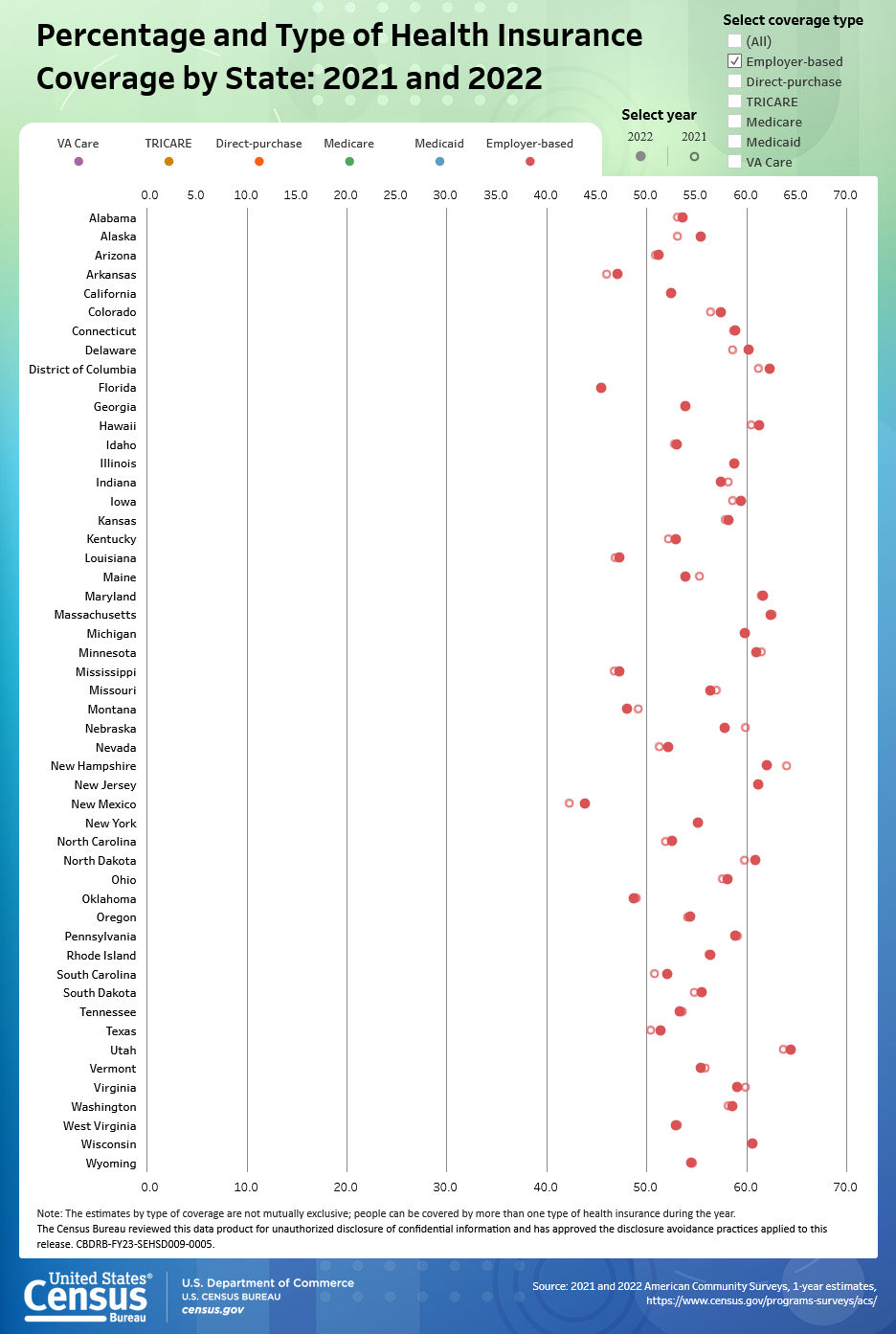Changes in Types of Health Insurance Coverage Contributed to Declines in Uninsured Rates From 2021 to 2022
The share of people without health insurance coverage decreased in 27 states between 2021 and 2022, according to a U.S. Census Bureau report released today.
In 25 states where the uninsured rate decreased, at least one of the many types of public or private insurance changed significantly. Only Utah and North Dakota had decreases in the uninsured rate without significant changes in the types of coverage.
Fifteen of the 27 states where uninsured rates dropped in 2022 had increases in Medicare coverage; eight had increases in Medicaid coverage; and six had increases in VA coverage.
Types of health insurance coverage include:
- Public coverage offered through Medicare, which provides coverage to most people aged 65 and older or with certain disabilities; Medicaid, which provides coverage to those with low incomes or a disability; or through the Department of Veterans Affairs (VA), which provides coverage to eligible veterans.
- Private coverage, which may be provided through an individual’s or family member’s employer; the marketplace exchange or a broker (direct purchase); or TRICARE for current or retired members of the military and their family members.
Two new visualization tools depict health insurance coverage rates and types by state based on the 2022 American Community Survey 1-year estimates. Users can compare estimates within and across geographic areas to see the types of coverage and percentage of people without insurance in their state.
Hover over the dots in the interactive figure below to explore the rates of uninsured in your state.
Note: Select the image to go to the interactive data visualization.
How Types of Public Health Insurance Coverage Changed Across States
Increases in the types of public health insurance coverage contributed to decreases in uninsured rates in a number of states in 2022.
Fifteen of the 27 states where uninsured rates dropped in 2022 had increases in Medicare coverage; eight had increases in Medicaid coverage; and six had increases in VA coverage.
Across the nation, 22 states with increases in public health insurance coverage types had either decreases or no changes in private health insurance coverage types. Eleven of these states had lower uninsured rates in 2022: Alabama, Illinois, Indiana, Michigan, Missouri, New Jersey, New York, Ohio, Oklahoma, South Dakota and Virginia.
Overall, Medicaid rates increased in 10 states in 2022 and all but one (Alabama) had expanded Medicaid eligibility on or before January 1, 2022.
Select a coverage type and hover over the dots in the visualization below to see the percentage and type of health insurance coverage in your state.
Note: Select the image to go to the interactive data visualization.
Changes in Private Health Insurance Coverage Types Across States
Changes in private health insurance coverage types also had an impact on uninsured rates in 2022.
What happened between 2021 and 2022:
- Of the 27 states that had decreases in uninsured rates in 2022, six experienced increases in employer-sponsored coverage and nine had increases in direct-purchase coverage. None of these states had increases in TRICARE coverage.
- Eight states with increases in private health insurance coverage types had either decreases or no changes in public health insurance coverage types: Colorado, Georgia, Kansas, Mississippi, Nevada, Rhode Island, South Carolina and Texas.
- Overall, employment-sponsored insurance coverage increased in Alaska, Arkansas, Colorado, Iowa, New Mexico, North Carolina, South Carolina and Texas.
- Employment-sponsored insurance coverage decreased in Indiana, Nebraska, New Hampshire and Virginia.
- Direct-purchase coverage increased in 13 states: Arizona, California, Florida, Georgia, Iowa, Kansas, Louisiana, Mississippi, New Hampshire, North Carolina, Rhode Island, Texas and Washington.
- Direct-purchase coverage decreased in Delaware, Kentucky, Minnesota, Missouri, New Mexico and Pennsylvania.
Related Statistics
Subscribe
Our email newsletter is sent out on the day we publish a story. Get an alert directly in your inbox to read, share and blog about our newest stories.
Contact our Public Information Office for media inquiries or interviews.
-
HealthHealth Insurance Coverage of U.S. Workers Increased in 2022September 12, 2023Health insurance coverage for working-age adults ages 19 to 64 improved in 2022 across race groups and Hispanic origin and in most regions.
-
HealthAbout 43 Million People in the U.S. Had Multiple Health Plans in 2021July 19, 2023More than half of multiple coverage holders had Medicare and a private coverage plan.
-
HealthFull-Time, Year-Round Workers More Likely to be Uninsured in 2021September 13, 2022The uninsured rate of those who worked less than full time, year-round dropped 1.2 percentage points from 2020 to 2021 as public coverage increased.
-
PopulationTribal Casinos: An Economic BoonNovember 20, 2025A new study explores how tribal casino expansion in the 1990s and 2000s affected poverty, jobs and income for American Indian communities and their neighbors.
-
NAICS Sector 31-33 ManufacturingSome Less Populous States Have High Manufacturing Revenue Per CapitaSeptember 29, 2025Today is the start of a week of celebrations at the Census Bureau marking the 14th annual Manufacturing Day on October 3.
-
Families and Living ArrangementsCouples’ Finances: Married but SeparateSeptember 24, 2025While most married couples had joint bank accounts, fewer shared all their financial accounts.
-
FertilityChildlessness on the Rise — Except for Women Ages 45 to 50September 23, 2025From 2014 to 2024, the share of older mothers rose as fewer teens and women in their 20s and 30s had children.






